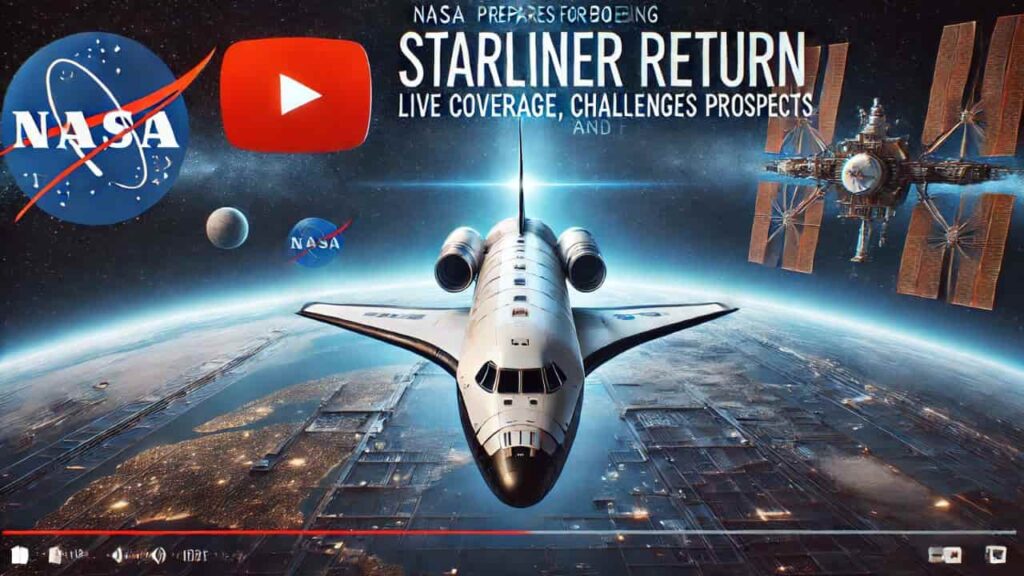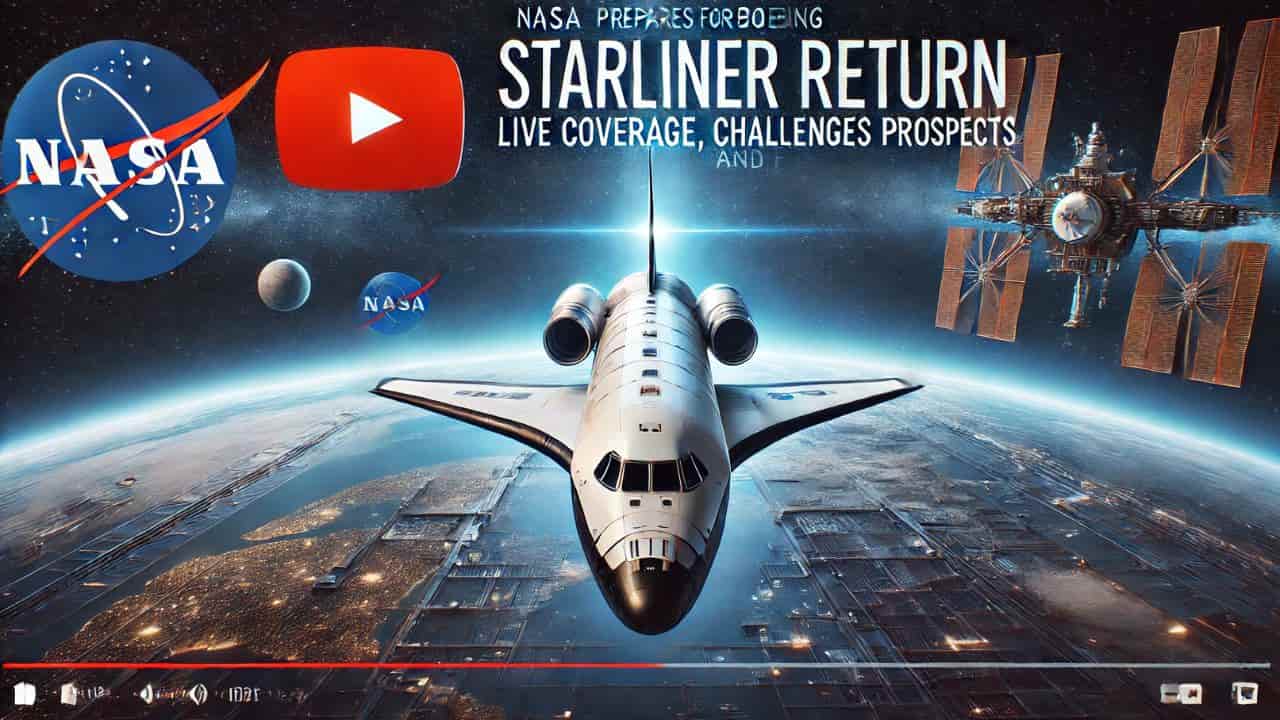NASA, Boeing Starliner, Starliner return, ISS, International Space Station, NASA live coverage, Starliner landing, space exploration, Commercial Crew Program, space transportation
NASA is set to provide live coverage as Boeing’s Starliner spacecraft returns from the International Space Station. Learn about the challenges faced, the future of the Starliner program, and how to follow the mission’s live updates.

Background and Importance of the Starliner Mission
The Starliner spacecraft was designed as part of NASA’s broader initiative to partner with private companies to provide transportation services to low Earth orbit and the ISS. This partnership is essential for maintaining a consistent human presence on the ISS, conducting scientific research, and fostering the development of new space technologies. The success of the Starliner missions is critical for NASA as it seeks to reduce its reliance on foreign spacecraft, particularly the Russian Soyuz, for transporting astronauts to the ISS.
NASA has announced its upcoming live coverage of Boeing’s Starliner spacecraft as it prepares to depart from the International Space Station (ISS) and return to Earth. This significant event marks another chapter in NASA’s ongoing collaboration with private industry to enhance space exploration and transportation capabilities. The Starliner spacecraft, developed by Boeing under NASA’s Commercial Crew Program, has been pivotal in testing and validating new technologies that will eventually enable the safe transport of astronauts to and from space.
The upcoming Starliner mission is particularly noteworthy because it involves the spacecraft’s first crewed flight, which had initially raised expectations and hopes for its successful execution. However, during its approach to the ISS, Boeing and NASA engineers identified technical issues, including helium leaks and problems with the spacecraft’s reaction control thrusters. These issues have necessitated a change in plans, and the Starliner will now return to Earth uncrewed, with NASA astronauts Butch Wilmore and Suni Williams remaining aboard the ISS until their return on the SpaceX Dragon spacecraft in February 2025.
Timeline of Events
The Starliner spacecraft is scheduled to undock from the ISS at approximately 6:04 p.m. EDT on Friday, Sept. 6, 2024, assuming favorable weather conditions. After undocking, the spacecraft will begin its descent towards Earth, targeting a landing at White Sands Space Harbor in New Mexico at around 12:03 a.m. EDT on Saturday, Sept. 7. This descent and landing will be a critical test of Starliner’s re-entry and landing systems, which are designed to ensure the spacecraft can safely return astronauts and cargo from space.
NASA will provide comprehensive live coverage of these events through multiple platforms, including NASA+, the NASA app, and the agency’s official website. This live coverage will allow the public and interested stakeholders to follow the mission in real-time, providing transparency and insight into the spacecraft’s operations.
Pre-Departure Activities
Before the Starliner spacecraft begins its journey back to Earth, NASA will host a pre-departure news conference at 12 p.m. EDT on Wednesday, Sept. 4, 2024. This conference will take place at NASA’s Johnson Space Center in Houston, Texas, and will feature key figures involved in the mission, including managers from NASA’s Commercial Crew and International Space Station programs, as well as a flight director. These experts will provide updates on the mission’s progress, discuss the technical challenges encountered, and outline the procedures that will be followed during Starliner’s return.
For members of the media interested in attending the pre-departure news conference in person, NASA has set a deadline of 5 p.m. EDT on Tuesday, Sept. 3, 2024, for U.S. media to contact the NASA Johnson newsroom. Those who wish to participate via phone must also contact the newsroom at least two hours before the start of the conference.
Challenges and Technical Issues
The journey of the Starliner spacecraft has not been without challenges. The detection of helium leaks and issues with the reaction control thrusters during its approach to the ISS were significant concerns. These technical difficulties prompted NASA and Boeing to prioritize the safety of the astronauts aboard the ISS, leading to the decision to bring the spacecraft back to Earth without its crew. While this outcome was not what NASA and Boeing had initially planned, it underscores the importance of rigorous testing and validation in space missions, where the safety of human life is paramount.
The decision to return the Starliner uncrewed also highlights the complexities and risks associated with space travel. Spacecraft systems must operate flawlessly in the harsh environment of space, where even minor technical issues can have serious consequences. The lessons learned from this mission will be invaluable for future flights, helping to improve the reliability and safety of the Starliner spacecraft.
Looking Ahead: The Future of the Starliner Program
Despite the setbacks encountered during this mission, the Starliner program remains a crucial component of NASA’s strategy for maintaining a robust and flexible space transportation infrastructure. The ability to send astronauts to and from the ISS using American spacecraft is a key goal for NASA, and the Commercial Crew Program plays a central role in achieving this objective.
The upcoming return of the Starliner spacecraft will provide valuable data that will inform future missions. Engineers and mission planners will closely analyze the performance of the spacecraft during its re-entry and landing, looking for any anomalies or areas where improvements can be made. This data will also be used to ensure that the issues encountered during this mission do not recur in future flights.
The Role of Public Engagement
NASA’s decision to provide live coverage of the Starliner’s return to Earth reflects the agency’s commitment to public engagement and transparency. By making these events accessible to the public, NASA allows people around the world to share in the excitement and challenges of space exploration. This transparency also helps to build trust and confidence in NASA’s missions, as the public can see firsthand how the agency handles the complexities and risks associated with space travel.
In addition to live coverage, NASA offers a variety of platforms and social media channels where the public can follow the mission. These platforms provide real-time updates, behind-the-scenes insights, and opportunities for the public to ask questions and engage with the mission. This level of engagement is crucial for inspiring the next generation of scientists, engineers, and space enthusiasts, who will play a vital role in the future of space exploration.
Conclusion
The upcoming return of the Boeing Starliner spacecraft marks a significant moment in NASA’s ongoing efforts to develop reliable and safe transportation systems for space. While the mission has faced challenges, the data and experience gained will be invaluable for future missions. The decision to return the spacecraft uncrewed, following the identification of technical issues, underscores NASA’s commitment to astronaut safety and the rigorous testing of all systems before they are used for crewed missions.
As NASA prepares for the Starliner’s return, the agency’s live coverage and public engagement efforts will allow people around the world to witness this important event. The lessons learned from this mission will help pave the way for future space exploration, ensuring that NASA and its partners continue to push the boundaries of what is possible in space. The Starliner program remains a critical part of NASA’s broader vision for the future of human spaceflight, and its success will have a lasting impact on the agency’s ability to achieve its goals.
Read More
- NASA and Sierra Space Dream Chaser Arrives in Florida for Launch Prep
- NASA Citizen Scientists Discover Hypervelocity Star Zooming Out of the Milky Way
- NASAs VIPER Moon Rover Exploring New Partnership Opportunities for Lunar Exploration
- NASA Invites Media to Northrop Grumman 21st Station Resupply Launch










